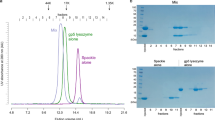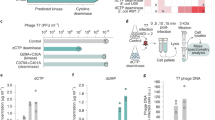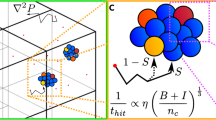Abstract
FROM experiments carried out by other authors1, who have exposed to ultra-violet light and to X-rays bacteria infected with different types of phages (T2, T7), it has been possible to obtain a general picture of the changes which take place during the latent period, from infection to the lysis of the host cells. It was found, in agreement also with other types of experiments, that phage T2 begins to multiply only about 7–9 min. after infection. During this period the particle is not infectious and is responsible for the changes in the host cell which lead to the synthesis of new virus. Study of this early period might thus furnish important information about the relationships established between virus and host cell.
This is a preview of subscription content, access via your institution
Access options
Subscribe to this journal
Receive 51 print issues and online access
$199.00 per year
only $3.90 per issue
Buy this article
- Purchase on Springer Link
- Instant access to full article PDF
Prices may be subject to local taxes which are calculated during checkout
Similar content being viewed by others
References
Latarjet, R., and Luria, S., Ann. Inst. Past., 73, 666 (1947). Latarjet, R., J. Gen. Physiol., 31, 529 (1948). Benzer, S., J. Bact., 63, 59 (1952).
Coppo, A., N. Ann. Ig. Microbiol. (in the press).
Castagnoli, C., and Graziosi, F., Nature, 174, 599 (1954).
Author information
Authors and Affiliations
Rights and permissions
About this article
Cite this article
CASTAGNOLI, C., DONINI, P. & GRAZIOSI, F. Inactivation of Phage due to Assimilated Phosphorus-32 and the Recovery of Host Cells. Nature 175, 992–993 (1955). https://doi.org/10.1038/175992b0
Issue Date:
DOI: https://doi.org/10.1038/175992b0
Comments
By submitting a comment you agree to abide by our Terms and Community Guidelines. If you find something abusive or that does not comply with our terms or guidelines please flag it as inappropriate.



